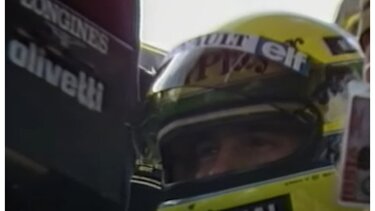Astonishingly for many, it is 35 years ago, in pouring rain...
...since Ayrton Senna achieved his first Formula 1 grand prix victory – and he did it using Renault power.
The year was 1985. The circuit was Estoril, by Portugal’s Algarve coastline.
In dry conditions, Senna had achieved a career-first pole position at the wheel of his Lotus – fitted with Renault’s latest-spec ‘EF4’ engine -a ‘Type B’ version of that used by the Lotus and Renault teams in 1984.
Its smooth power delivery – honed by Renault’s expertise since it introduced turbocharging technology in 1977 – would then play perfectly into his hands when monsoon conditions greeted the drivers for the race.
Senna maintained his pole position advantage at the start and then, using his extraordinary natural skill, eased away from his pursuers. He would lead every lap and lapped every other driver except one.
Closest to him in the early stages was Lotus Renault team-mate Elio de Angelis but a mistake later on in the race dropped the Italian to fourth. However there was still to be a second Renault-powered car on the podium – that of Renault team driver Patrick Tambay. The Frenchman’s third place was to be the final podium result for the factory Renault team of the era…
Meanwhile, Senna was able to motor serenely on his way for a famous first victory, although it was not without its frights due to aquaplaning along Estoril’s two long straights. There was also the matter on a wet track surface of having to control the surge of 800bhp through the rear wheels mid-way through and exiting corners.
Senna himself admitted later he had been off the track at least once, lucky to avoid contact with the barriers.
The image, though, of him entering the pit lane and parc ferme, belts undone, arms aloft, fists clenched and being greeted by the Lotus and Renault personnel will forever be one of the most iconic in F1 history.
Watch F1’s official highlights of that race here.
In peculiar circumstances, a Lotus-Renault would win the following San Marino GP, too, held at the Imola circuit, but it was not Senna’s… having led the race Senna then retired late on and, when Alain Prost’s McLaren which eventually crossed the line first was later disqualified for being underweight, it was de Angelis, next up on the road in the second Lotus-Renault, who was declared the winner.
But for F1 fans, Portugal 1985 remains a landmark moment in their sport’s history for it is where the highly successful Senna-Lotus-Renault combination started to come good in only its second event together.
Senna would go on to achieve six more pole positions that year (making it an unrivalled seven from a possible 16) and, in changeable wet-dry conditions, he would win again towards the end of 1985 at the legendary Spa-Francorchamps circuit in Belgium.
By now, Renault had introduced a newer-spec engine, the ‘EF15’, which was more fuel efficient than its predecessor with power now reaching the 1000bhp barrier.
More success would follow in 1986 when Senna, using Renault’s ‘EF15B’ and, later, ‘C’ engine designs with pioneering pneumatic valve timing and power in qualifying trim now put at 1200bhp, achieved a further eight pole positions and two race wins.
The sight of Senna taming his black and gold Lotus and the sound of those Renault engines as he controlled the throttle will forever make for some of F1’s most evocative memories.






